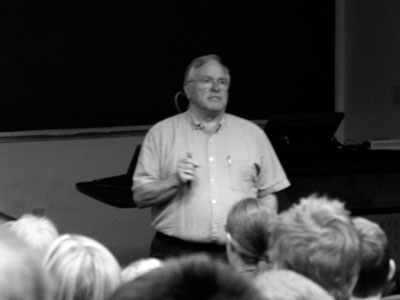“Now we have engines that could literally fly a brick. Aerodynamics people get mad when you say that, but we can.”
This bold, but true statement was made by Dr. James Williams of Ohio State University at the Metallurgical and Materials Engineering seminar about aero-propulsion and the role of materials in this most interesting of sciences.
As Williams explained, and as everyone knows, the aerospace industry is heavily cost driven. Until the 1960s, aircraft were propulsion limited, meaning thrust was a major design constraint. It was not until this challenge was overcome that passenger aircraft became feasible. As the focus shifted towards commercial engines in aircraft and away from the military, cost became an ever-increasing factor.
When this shift occurred, plane factors expanded from reliability, cost of ownership, and fuel consumption to include noise and emissions as well. Operating costs, aircraft range, route flexibility, and carbon emissions are all major implications associated with fuel efficiency, so with the added constraints, it became increasingly difficult to improve on the original design criteria.
“Landing noise is a hard problem; If you’re gonna land the plane, the landing gear had better be down and it makes noise… but it’s important that it’s there.” But while some issues, such as landing noise are difficult to fix, the material design of the engine can go a long ways in improving many of design aspects.
Williams explained improved engine performance as an “interdisciplinary success story” and related it to a three legged stool. The legs of the stool are made of up higher temperature allowances, lighter weight designs, and component efficiency. The so called “sturdiness” of the legs relies heavily on the characteristics of the materials chosen in the engine design.
In reality, the “perfect engine components” are an impossible engineering dream. Higher operating temperatures can be achieved simply by using “better materials.” The problem lies in the fact that introducing new disk material costs upwards of $35 million. Even worse is the breakdown of the costs, “It only costs two to three million dollars to design a new disk or new component; the rest goes to gathering data about the performance of the new components.” It often makes sense to find materials that work and stick with them, even if the resulting components are not as great as they could be.
In addition to performance benefits, Williams shared some of the reliability improvements that were brought about through smart materials engineering. New turbine blades can be made of stronger materials than before while retaining (or improving upon) the original turbine blade densities. Other improvements, such as nanometer coatings, allow for improved performance as well as increased durability. Williams explained the purpose of coatings, “Having the coating allows you to repartition the cooling air between the leading edge and the flank of the blade. This allows higher temperatures in the turbine while retaining close to the same weight.”
Williams finished by showing some images of real world wear to exemplify the characteristics of improved materials choices. If there is anything the aerodynamics industry shows, it is that improvements can always be made through better choice of materials, if price is no object. In such a cost driven industry, however, design is always a balancing act and will provide engineering problems for generations to come.



'MME Lecture: Aero propulsion' has no comments
Be the first to comment this post!